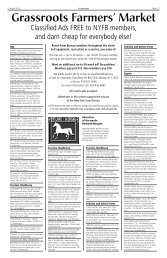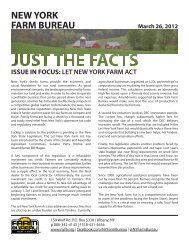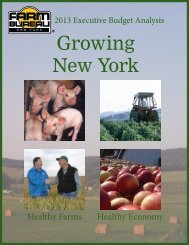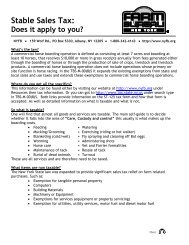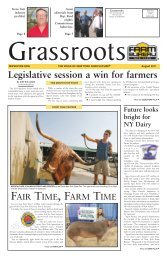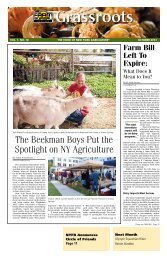Facebook brings a flood of relief to frazzled farmers - New York Farm ...
Facebook brings a flood of relief to frazzled farmers - New York Farm ...
Facebook brings a flood of relief to frazzled farmers - New York Farm ...
You also want an ePaper? Increase the reach of your titles
YUMPU automatically turns print PDFs into web optimized ePapers that Google loves.
Page 6 Grassroots November 2011<br />
Commodity report: Poultry<br />
Impact on local economies is not just chicken feed<br />
By Alan Knight<br />
aknight@nyfb.org<br />
The s<strong>to</strong>ry <strong>of</strong> poultry production in<br />
<strong>New</strong> <strong>York</strong> can be summed up by that<br />
trite old expression: location, location,<br />
location.<br />
There is, <strong>of</strong> course, more <strong>to</strong> it than<br />
that: globalization, vertical integration,<br />
transportation costs, access <strong>to</strong> low-cost<br />
grain (which depends on transportation<br />
costs—fuel costs—and thus location),<br />
regional competitive advantage<br />
(another way <strong>of</strong> saying location), environmental<br />
regulations (<strong>of</strong>ten a function<br />
<strong>of</strong> population density and thus location)<br />
and entrepreneurial personalities.<br />
<strong>New</strong> <strong>York</strong>’s poultry business isn’t<br />
what it used <strong>to</strong> be. Nor will it remain<br />
what it is.<br />
Egg production and broiler production<br />
were widely scattered in the early<br />
and mid 1900s. Entrepreneurs grew<br />
their birds within a three-hour drive<br />
<strong>of</strong> major cities. Two- and three-s<strong>to</strong>ry<br />
chicken houses were common in Maine<br />
and around Fitchburg, Mass., <strong>to</strong> serve<br />
the Bos<strong>to</strong>n market, and in the Catskills<br />
<strong>to</strong> serve <strong>New</strong> <strong>York</strong> City. As many as 7.5<br />
million ducks per year were produced<br />
on Long Island around1950.<br />
Beginning in the late 1950s and early<br />
1960s, suburban expansion began <strong>to</strong> collide<br />
with animal agriculture, leading <strong>to</strong><br />
environmental regulations and the cost<br />
<strong>of</strong> complying.<br />
Out-<strong>of</strong>-state competi<strong>to</strong>rs<br />
By the 1970s, completion <strong>of</strong> the interstate<br />
highway system meant Ohio<br />
eggs and Georgia broilers (and even<br />
processed ducks from Indiana and Wisconsin)<br />
could be hauled in<strong>to</strong> northeastern<br />
cities in less than 24 hours. Those<br />
eggs and those broilers, produced with<br />
cheap nearby grains, <strong>of</strong>ten could—and<br />
did—out-compete locally produced<br />
poultry products.<br />
The shape-shifting <strong>of</strong> <strong>New</strong> <strong>York</strong>’s<br />
poultry business had begun.<br />
The shrinking <strong>of</strong> Long Island’s<br />
duck industry serves <strong>to</strong> illustrate these<br />
points. Begun in the 1880s by agricultural<br />
entrepreneurs, the duck-farming<br />
industry there had 90 producers in<br />
the 1930s and 70 in the 1950s. A collision<br />
<strong>of</strong> fac<strong>to</strong>rs shrank the industry<br />
<strong>to</strong> 48 producers by 1963 and only three<br />
<strong>to</strong>day: “normal” consolidation, suburban<br />
and summer-home encroachment,<br />
and manure management problems. All<br />
those millions <strong>of</strong> ducks made a mess<br />
<strong>of</strong> streams and estuaries and newlyarrived<br />
homeowners were not pleased.<br />
Plus, rapidly advancing suburbanization<br />
gobbled up lands that formerly<br />
produced grain for the ducks. The costs<br />
<strong>of</strong> cleaning up their act and hauling in<br />
grain from the Midwest were <strong>to</strong>o much<br />
for most Long Island duck producers <strong>to</strong><br />
bear.<br />
Numbers tell the s<strong>to</strong>ry<br />
Look at some his<strong>to</strong>rical numbers. In<br />
1934, according <strong>to</strong> the National Agricultural<br />
Statistics Service, <strong>New</strong> <strong>York</strong> State<br />
<strong>farmers</strong> produced 1.2 million broilers.<br />
By 1957, the number had peaked at<br />
14.6 million. In 1979, it bot<strong>to</strong>med-out at<br />
520,000 birds and since then has been<br />
erratically inching back up <strong>to</strong> about<br />
three million. Compared <strong>to</strong> national<br />
and global production <strong>of</strong> broiler-birds,<br />
<strong>New</strong> <strong>York</strong>’s production is tiny.<br />
How tiny? World broiler production<br />
is expected <strong>to</strong> reach 76.2 million <strong>to</strong>ns in<br />
2011 (an 18 percent increase over 2006).<br />
U.S. production for 2011 is expected <strong>to</strong><br />
hit 16.6 million <strong>to</strong>ns, about 22 percent <strong>of</strong><br />
world production.<br />
<strong>New</strong> <strong>York</strong> production in 2004, the last<br />
year the National Agricultural Statistics<br />
Service thought it worth publishing<br />
the number for <strong>New</strong> <strong>York</strong>, production<br />
was 7,300 <strong>to</strong>ns, or 0.0004 percent <strong>of</strong> U.S.<br />
Pasture-raised poultry: the doubling in the number <strong>of</strong> <strong>farmers</strong>’ markets in <strong>New</strong> <strong>York</strong> has encouraged the production <strong>of</strong> nichemarket<br />
poultry, although it still comprises a very small percentage <strong>of</strong> the state’s egg and meat-bird production.<br />
production.<br />
<strong>New</strong> <strong>York</strong>’s egg production patterns<br />
over the past century have been somewhat<br />
different. In 1934, <strong>New</strong> <strong>York</strong> <strong>farmers</strong><br />
produced 1.5 billion eggs. <strong>New</strong> <strong>York</strong><br />
egg production peaked in 1944, feeding a<br />
nation at war, with 2.4 billion eggs and<br />
again in 1968, after which statewide production<br />
began <strong>to</strong> slide steadily and hitting<br />
bot<strong>to</strong>m in 1997 at 931 million.<br />
In 2006, <strong>New</strong> <strong>York</strong> <strong>farmers</strong> produced<br />
83.3 million dozen eggs. U.S. <strong>farmers</strong><br />
produced 5.3 billion dozen. China produced<br />
25.3 billion dozen. Worldwide<br />
production was 61.1 billion dozen. In<br />
the period 1986-2006, China increased<br />
its output <strong>of</strong> eggs 450 percent.<br />
<strong>New</strong> <strong>York</strong> egg production has been<br />
holding steady since 2001.<br />
On a world scale, <strong>New</strong> <strong>York</strong>’s production<br />
may be small. But statistics can be<br />
misleading. Impact on local economies<br />
cannot be ignored.<br />
“Poultry is still the number one agricultural<br />
enterprise in Sullivan County<br />
<strong>to</strong>day,” said Jerry Skoda, former Cornell<br />
Cooperative Extension agricultural<br />
agent in Sullivan County. “We currently<br />
have two large egg complexes; the two<br />
large duck farms operating at several<br />
locations; a very large broiler producer<br />
who owns several <strong>of</strong> the former egg<br />
complexes and has several contract<br />
growers, and has built new buildings.<br />
We also have a large number <strong>of</strong> new<br />
<strong>farmers</strong> producing natural, organic,<br />
free-range, and pastured eggs and meat<br />
birds.”<br />
<strong>Farm</strong>ers’ Markets <strong>to</strong> the rescue<br />
The rapid increase in the number <strong>of</strong><br />
<strong>farmers</strong> markets in <strong>New</strong> <strong>York</strong> (235 <strong>farmers</strong><br />
markets in 2000; approximately 500<br />
this year) is also having a noticeable<br />
impact on small-scale poultry production.<br />
“Meat is becoming increasingly<br />
popular at <strong>farmers</strong> markets and we find<br />
more meat producers in markets each<br />
year,” says Diane Eggert, executive direc<strong>to</strong>r<br />
<strong>of</strong> the <strong>Farm</strong>ers Market Federation<br />
<strong>of</strong> <strong>New</strong> <strong>York</strong>. But that includes all<br />
meats, not just poultry. And I find eggs<br />
<strong>to</strong> be a market staple.”<br />
The shape-shifting continues.<br />
Helping entrepreneurs<br />
find that golden egg<br />
Numerous <strong>New</strong> <strong>York</strong> <strong>Farm</strong> Viability<br />
Institute projects focus<br />
on helping <strong>farmers</strong> identify<br />
enterprise options and access<br />
new markets. One such<br />
project helped North Country<br />
<strong>farmers</strong> identify alternatives<br />
that would most effectively<br />
utilize their production resources.<br />
Cooperative Extension<br />
educa<strong>to</strong>r Bernadette<br />
Logozar worked with Todd and<br />
Michelle Asselin <strong>of</strong> Harmony<br />
Hills <strong>Farm</strong>stead in Duane, N.Y.<br />
<strong>to</strong> identify alternatives and develop<br />
a business and marketing<br />
plan. They currently raise<br />
Cornish cross birds for meat,<br />
layers, rabbits, turkeys, swine<br />
and beef. Today, the Asselins<br />
have a thriving and growing<br />
direct farm marketing business<br />
that utilizes a website, on-farm<br />
sales, drop location delivery<br />
and a <strong>farmers</strong>’ market.



